Do you recognize which brands the images below belong to?

Iconic ear pods

Sleek laptop in chrome

One of the most popular 70-year old car model
If you answered yes, then that’s brand consistency at work. Even without the names embossed on the products, they are brands that customers recognize at a glance.
The good news is you can achieve the same brand recognition with the help of companies offering brand design services. But before anything else, having fundamental knowledge about brand consistency is a great first step in unlocking its benefits.
If you’re new to branding or seeking ways to increase your brand value, this article is for you. We will also share some helpful tips from branding experts on establishing brand guidelines for maintaining branding consistency.
What Is Brand Consistency?
Brand consistency is what you get when implementing cohesive visual elements, brand tone, and brand voice in all your collaterals. It entails strict adherence and commitment to delivering a consistent brand message and brand values across all marketing channels, too.
In effect, brand consistency snowballs to your overall brand health, making your business more reliable, relatable, and relevant.
Picture this; Say Nike offers the same quality products to its market but with a slight change. Instead of the 'swoosh' logo, they are now replacing it with an X-mark logo. Or what if after visiting Apple's website, you scroll through the page with extra chunky text and vibrant background instead of the brand's signature minimalist design?
These may seem trivial changes to you, but such brand inconsistencies are enough to cloud the minds of consumers on whether they can still trust your business. It deters brand recognition. They may think they are talking to a different brand and that the products they love may not have the same quality as before.
It goes without saying that a consistent brand becomes an essential element of your business' success. Let’s parse that down further.
Why Brand Consistency Is Key to Brand Success
Many businesses are keen to achieve brand consistency simply because it works. That sense of familiarity and predictability creates a bond with your target market that is difficult to forge. While it is difficult to attain, brand consistency brings forth so many lasting advantages like the following:
Brand consistency helps nurture meaningful customer relationships
Trust is the very foundation of an excellent brand experience. Customers are more comfortable knowing that the brand can meet their expectations. It's the same way we feel safe with a friend than with a stranger.
That’s probably why brands that undergo mergers and acquisitions lose a huge chunk of their existing audience because of the changes brought in. There is a disconnect between the existing and potential customers and the new branding team. In effect, Forbes reports that over 90% of mergers fail.
Brand consistency ensures the easy creation of cohesive marketing content
One important tool in achieving brand consistency is a brand guideline. With it, you can access a set of formats you can use and tailor according to your desired content. And this advantage cannot be stressed enough, especially when your brand is on multiple channels. Cohesive branding also prevents the likelihood of confusion when delivering your brand message, thus attracting potential customers.
Brand consistency results in strong brand recognition and a positive brand image
When you combine the abovementioned advantages, you can attain brand recognition and effectively shape a positive brand perception from your audience. And since you don’t need to fight hard anymore for brand awareness, brand consistency allows you to focus on bigger objectives, like delivering innovative products and services that your market will love.
That's not to say that change is bad for business and can deter brand consistency. Even the preference and beliefs of your consumers alter due to cultural, economic, and social factors. It's important to realize that evolution is vital in your brand consistency strategy. However, you should still be able to evolve while maintaining the core image and brand values that your audience resonates with.
Strategies to Ensure Brand Consistency For Your Business
So, how can you ensure brand consistency for your business? Well, read on as we share the fundamental steps you can implement—whether you’re a startup or a big company.
1. Identify Your Core Audience and Brand Message
It takes several tries to determine your target audience, especially if you have multiple products catering to different needs and people. Hence, your first step to ensuring consistency is creating a brand persona.
A brand persona is your business in its human form that embodies a set of characters, attitudes, and beliefs or views representing your target audience. If the clothing brand H&M were a person, you’ll have someone young, very chic, and fears missing out on the latest fashion trends. Outdoor clothing and accessories brand Patagonia could be characterized as an adventurous individual who pushes boundaries and is environmentally conscious.
With that in mind, can you describe your brand persona?
Having a brand persona makes it easier for brand teams to visualize who they are talking to and create key messages that they can connect with. A brand persona is also instrumental when choosing your brand partner, brand ambassadors, and marketing channel. It's like selecting like-minded people that you can be friends with.
But the brand persona may undergo some changes and development, too. Hence, keeping your pulse on the market at all times is essential. Leverage social media listening tools to keep track of mentions, engagement, and feedback on social media and forums. You can also tag your sales and customer service teams to gather first-hand insights regarding your brand. Knowing your audience like the back of your hand can help make data-backed branding decisions and strategies.
2. Have A Brand Style Guide
Your brand guideline is your rulebook or brand bible, containing the framework, mission, and core values. It also outlines the visual design or brand identity elements, such as your choice of font, color palette, imagery, photography, and vector icons. With brand guidelines in place, business leaders can ensure that their brand and marketing teams are aligned when executing campaigns. There is a lower risk of confusion and failure.
We’ll discuss more effective ways to create fool-proof brand guidelines later!
3. Take Advantage of Brand Asset Management Tools
When managing multiple brand campaigns, staying organized can steer clear of chaos. And one way to achieve this is for brand managers to leverage brand or digital asset management tools.
But what is a brand asset management tool?
A brand asset management tool or software helps a brand manager become more productive and efficient by creating a central hub of all digital branding assets accessible by your team. These marketing assets include your latest logos, fonts, and other visual elements used in marketing and branding efforts. A centralized repository gives you a bird’s eye view of how your consistent brand identity evolves in real time and makes brand audits a breeze.
Additionally, brand asset management software can help businesses with multiple sub-brands. For example, one feature of such tools allows a brand manager to segregate marketing assets per sub-brand so that only a specific team can access them and avoid unwanted changes, thereby creating a consistent brand.
4. Set a Social Media Game Plan
Remember the saying: Out of sight, out of mind. Well, the same concept applies to branding and marketing, too.
With so many businesses competing for attention, your business can easily drown in the crowd. That’s why companies investing in digital campaigns tripled as brands try to be present and build a consistent brand image. Add the shift in customer expectations of seamless brand experience online and offline.
While omnipresent marketing efforts can do wonders to ensure maximum exposure, it pays to be strategic about where and when your brand should appear. After all, brand awareness is not enough to strengthen your business.
Here are tried-and-tested tips you can take into account for social media campaigns that are brand consistent:
a. Run periodic social media audits.
A social media audit is when you track your past and current activities and progress in the digital space. With a bigger picture of your social media presence, you can identify gaps you may have easily missed and weed out campaigns and marketing materials that are no longer working. You can focus on strategies that are on brand.
b. Create a social media calendar.
When creating an on-brand social media calendar, you need to keep your goals and audience at its core. Doing so helps prioritize your content accordingly and saves you from confusion, especially when running marketing campaigns on multiple social media channels.
It’s also crucial to post on brand social media content consistently and timed when your online users are most active. Finally, a well-planned social media calendar provides enough time for your team to sift through all posts and catch errors.

Create social media calendars in a jiff. Source via Planable
Pro tip: Use free social media calendars tools like Zoho Social, Hootsuite, and Crowdfire, to name a few. They allow you to manage multiple social media channels in one dashboard.
c. Be engaging.
It is not enough to keep an active appearance by regularly posting content on social media. You have to be approachable and inspire your audience to engage with you.
Why not run interactive activities? You can ask for feedback or share user-generated content on your social media. You can also host live events and let your consumers participate. Or create a more personal experience by giving them a behind-the-brand peek and letting your team engage with them directly. People appreciate brands that commit to genuine relationship building over being transactional. Aside from implementing consistent branding, consumers gravitate towards consistent customer experience.
5. Be Authentic to Your Brand’s Core Values and Identity
In an evolving society where consumers seek authenticity, a business that can deliver a consistent experience and brand promise wins the race by miles. They want to see and feel the values and beliefs of brands in action. Or simply put, you need to walk the talk.
That said, while supporting a great cause can bring a positive impact on society, improve customer experience, and build brand consistency, it is best to execute campaigns that reflect your brand and truly resonate with your audience.
Take outdoors brand The North Face as an example of brand inauthenticity. A few years ago, the brand wanted to further its market reach worldwide and attract outdoor enthusiasts.
Their strategy was to upload subtly branded images on Wikipedia pages of adventure spots in various countries. You’ll see a picturesque image of a mountain but with a hiker sporting The North Face bag. The best part? It didn’t cost the brand much because Wikipedia allows people to edit and improve pages freely.
However, the campaign backfired, and Wikipedia was not happy with the brand’s violation of its rules, eventually deleting or cropping the brand from the images. Wikipedia has also released a reminder to its users and best practices to avoid committing the same mistake.
While the campaign did make noise for the brand, the people felt that The North Face was far from genuine and exploitative of their trust. Thus, affecting the customer experience. Yikes!

The North Face encounters backlash for exploiting Wikipedia via NYTimes
Best Practices When Creating Your Brand Guideline
Use Your Brand Story As Your Style Guideline’s Foundation
Your brand's story lays out the groundwork for establishing your brand guideline. It tells your audience why your brand exists and how it can help them improve their lives. Your brand story humanizes your business, a crucial strategy to aid in identifying which emotions to evoke and how to connect with your audience. These factors eventually form the same visual elements, tone, and voice that best reflect your brand.
For instance, many see B2B tech companies as serious, technical, and not-so-fun. But tech company Cisco veers away from this misconception by using photos and visual elements that depict genuine emotions. Cisco also followed through by creating innovative consumer-centric products. The brand even goes as far as capturing thousands of brand-exclusive images in different categories and creating a library its team can access to ensure consistency.
Create A Timeless Brand Identity
Businesses go through several iterations as they grow. In a couple of years, your business may be up for product line or market expansion. It is inevitable then for your brand guideline to adapt to these changes. These changes signal to your audience the direction your brand is taking and what they can look forward to. Hence, creating brand identity elements that are timeless and strategic is essential for a successful brand guideline.
Shell, an oil and gas company, is an excellent example of having timeless visuals. With slight alterations in the orientation of the shell, font, color palette, and style, the brand logo has managed to stay relevant. Now, it boasts a sleek, modern, and refined logo—symbolic of the company’s commitment to modern innovation. It has also succeeded in becoming an easily recognizable brand worldwide. Case in point, Shell holds the highest brand value in the oil and gas industry.
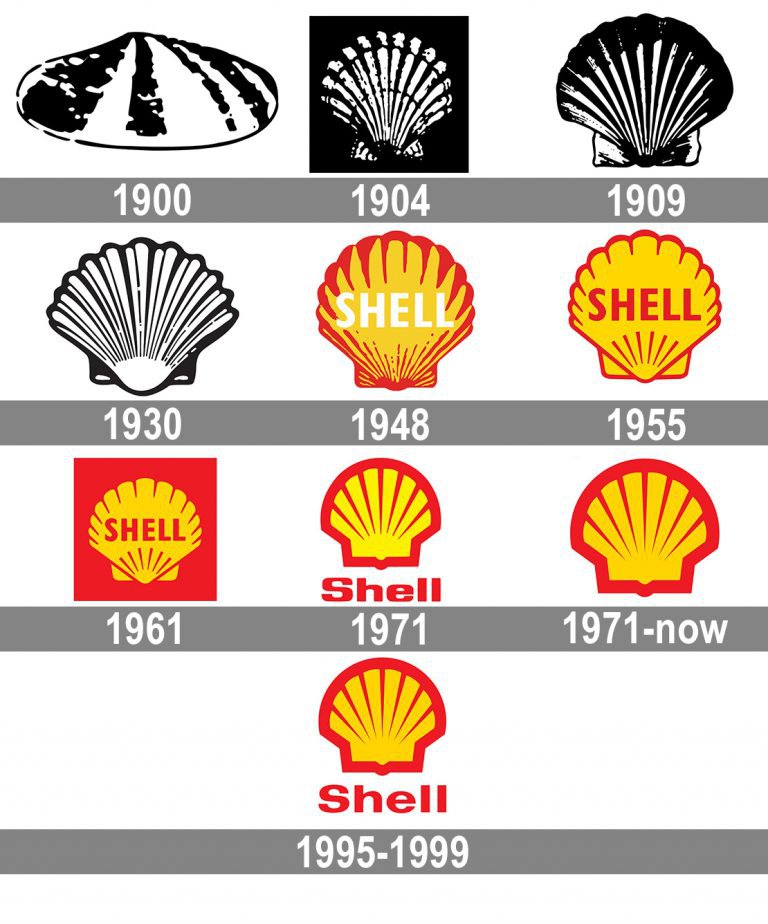
Shell maintains brand value at an all-time high via 1000 Logos
Starbucks’ iconic siren has remained prominent in its logo iteration. The popular coffee brand has also maintained the use of illustrations and images that reflect friendliness, are artful, and are environmental. Such globally identifiable and relatable visual and intangible elements are vital for a brand that is present in hundreds of countries.
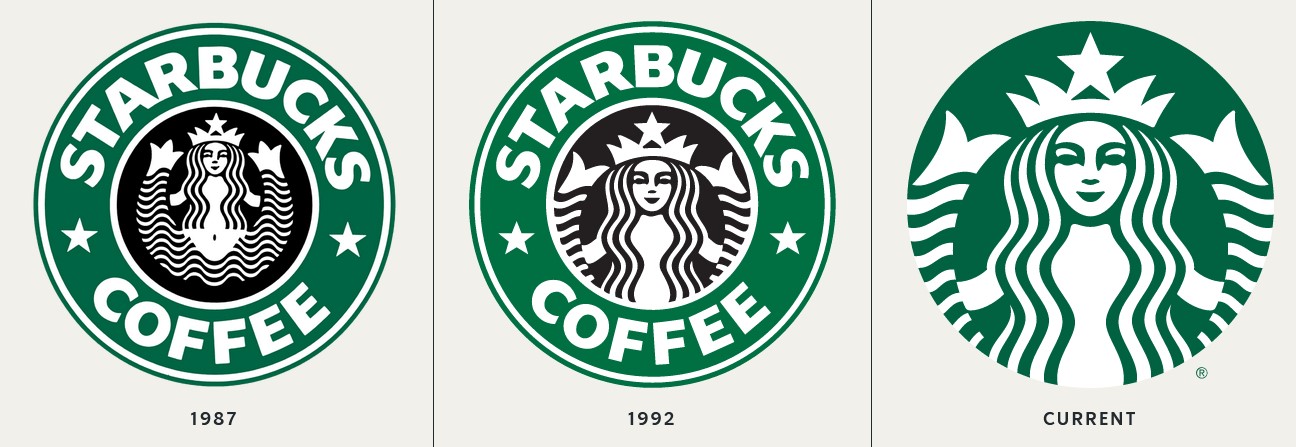
Evolution of the iconic siren logo via Starbucks

Candid and on-brand photos of people and places via Starbucks

Fun and artistic merchandise illustrations via Starbucks
Be Clear and Concise With Your Rules and Expectations
Not everyone on your team is a designer. They may not have the technical know-how of why colors or backgrounds are in your brand guideline. That said, your brand guideline should contain easy-to-follow rules and expectations.
One way to do this is to incorporate storytelling that carefully outlines your brand’s origin and how each design element signifies your brand’s facets. Simplify the do’s and don’ts that leave no room for misinterpretation. Finally, create clear-cut instructions.
Take your cue from Salt Bae’s restaurant Nusr-et brand guideline. Instead of lengthy texts, straight-to-the-point illustrations explain what to avoid when using its brand logo and font. Doing so makes cross-checking and assessing creative collaterals easy. It also helps maintain consistency.
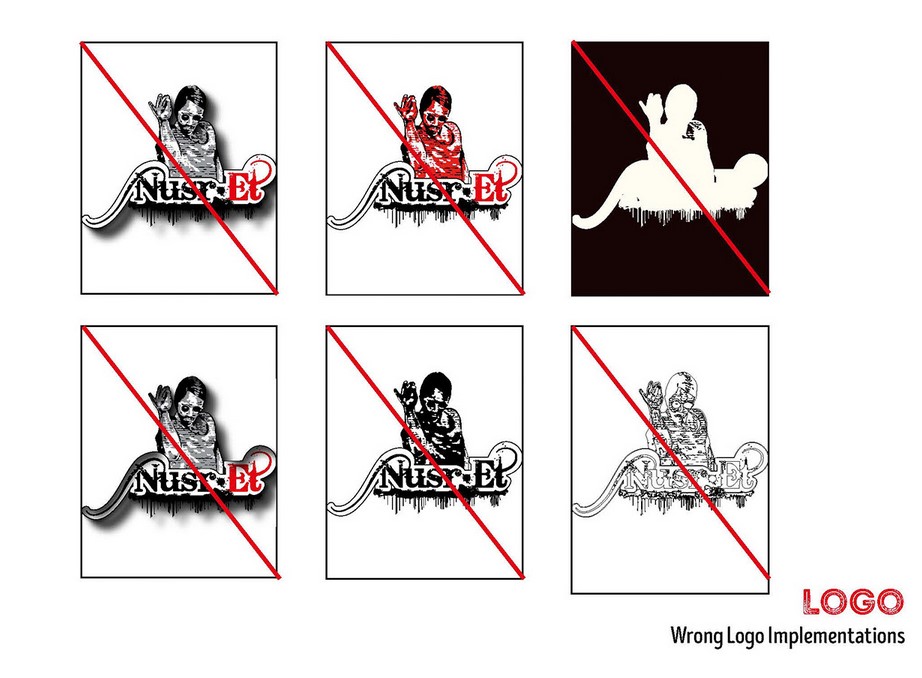
Do’s and don’ts of Nusr-Etr’s logo via Behance
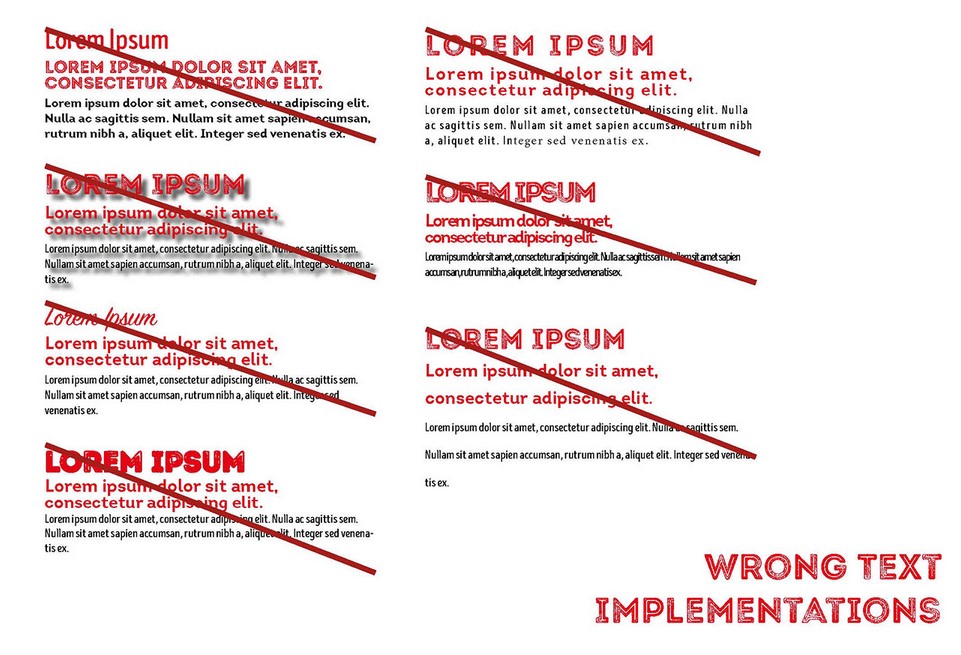
Do’s and don’ts of Nusr-Etr’s text via Behance
Here are more examples to inspire you.
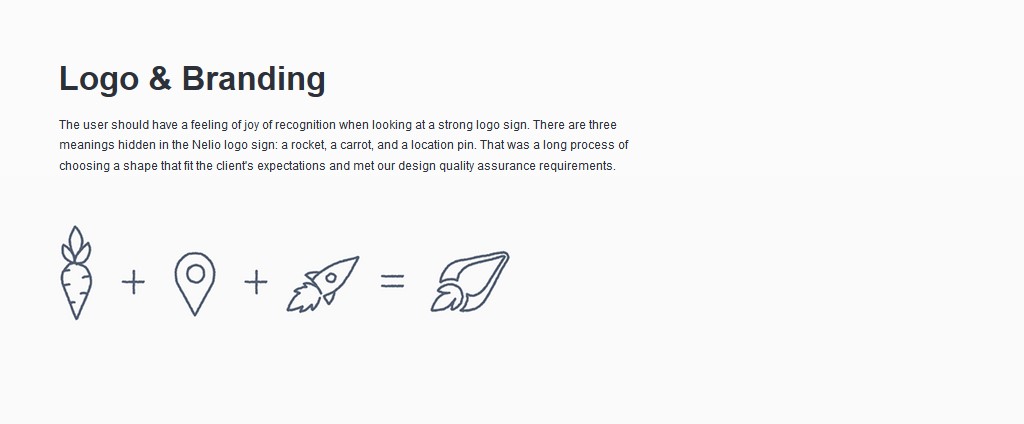
Clear explanation of Nelio’s logo creation via Behance
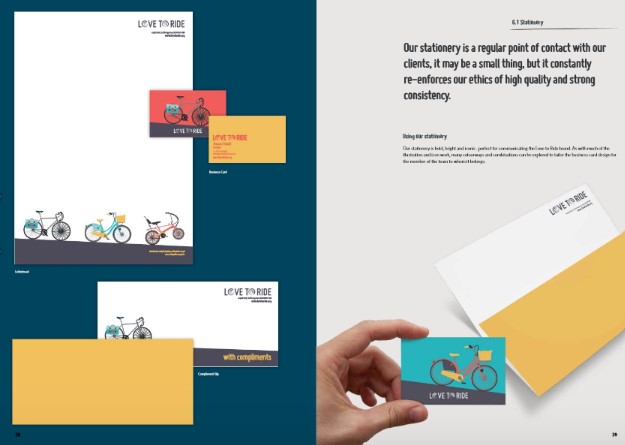
Love to Ride re-enforces its brand ethics on its stationery via Issuu
Orient Your People On Your Brand Guideline
There’s a misconception that a brand guideline is the sole responsibility of the branding team. However, a brand guideline requires the collective effort of everyone in your business, including your sales and customer support teams. After all, they are more familiar with your target customers as they are constantly in touch with them on the ground. You can also depend on your tech team—developers and UX/UI designers—to get more feedback on user behavior.
That said, it is vital to keep all stakeholders updated on any brand guideline development. Whether it’s a simple business card redesign or a total website revamp, they should know why the change was necessary and what it says about your brand. Doing so helps them to become on-brand when representing your business to consumers.
Remain Consistent In Your Branding With Expert Help
Achieving brand consistency is not a walk in the park, especially for startups and small businesses. It takes a lot of persistence, resources, and dedication. Even the big brands we know today took decades before they perfected the formula to brand consistency and gained its many benefits.
Aside from increased brand awareness, brand consistency can help you foster a positive brand image, strengthen brand authority, and empower your business to pursue upward mobility. In short, maintaining brand consistency can enable your business to weather any barriers, outcompete other brands, and earn the trust of your audience for many years to come.
Now, isn’t that worth it? All you have to do is trust the process. If you’re ready to create a strong brand through consistent marketing collateral, let our expert brand specialists guide you through the process and take your business to greater heights!
Mar 7, 2023
